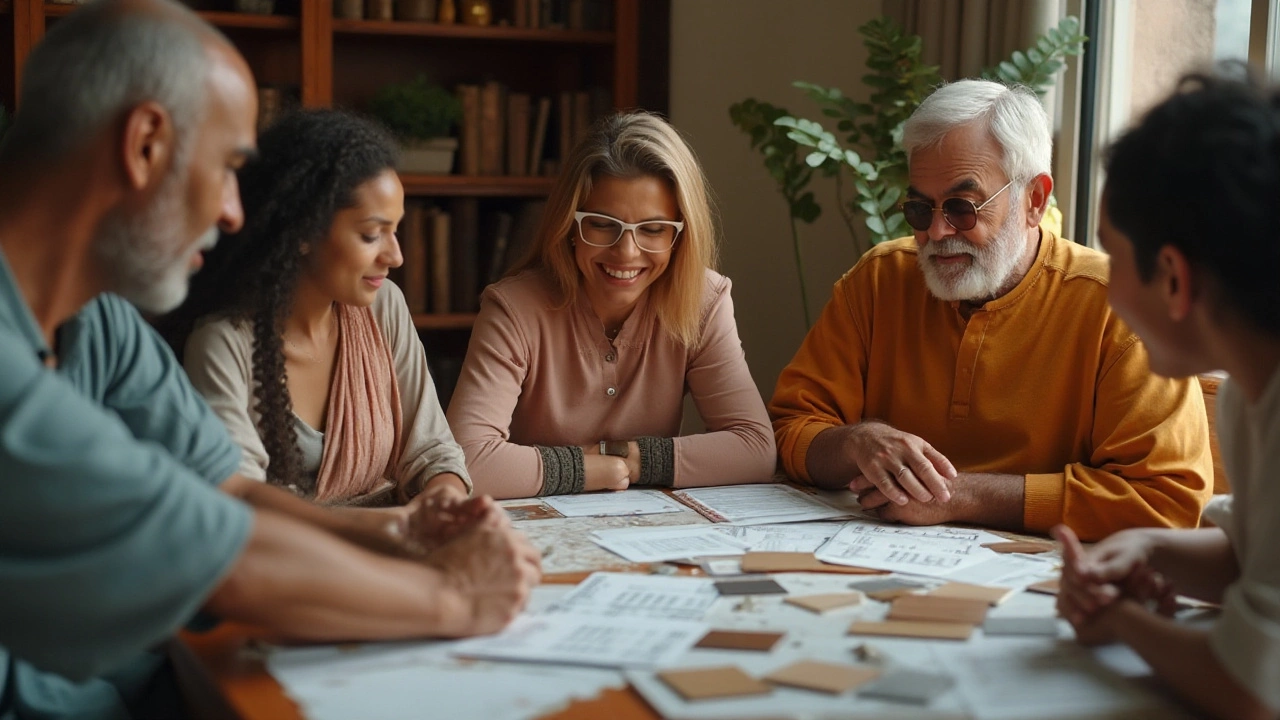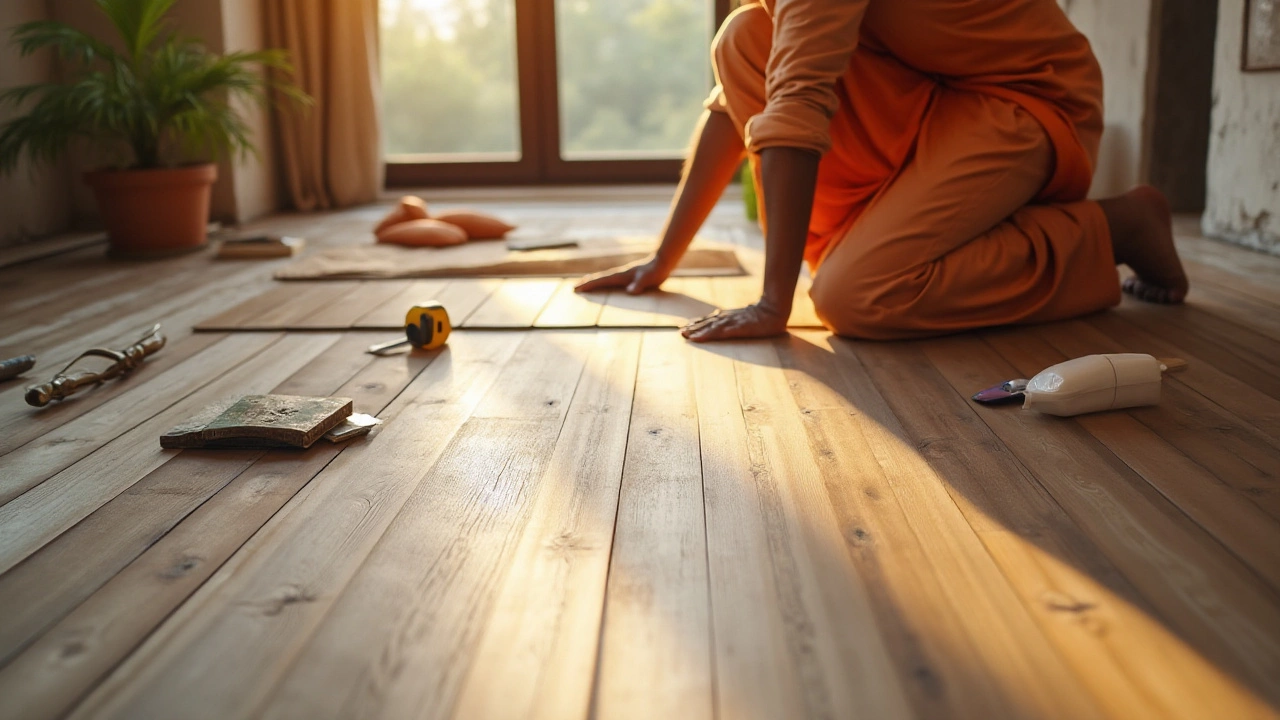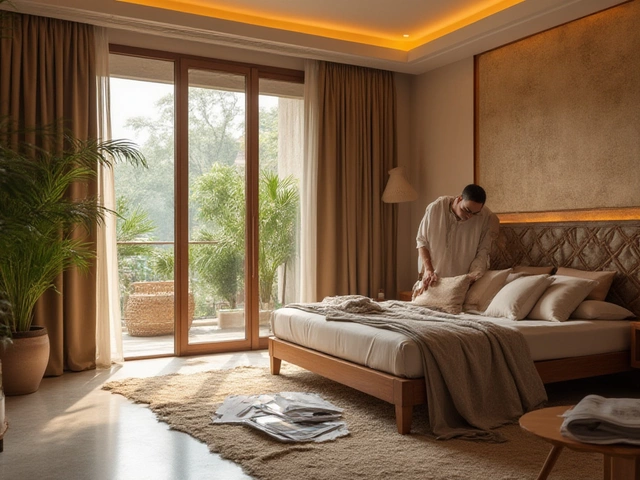When considering a new look for your floors, vinyl might be hitting the top of your list, and for a good reason. Known for its durability and affordability, vinyl flooring gives any room a fresh makeover without breaking the bank. The costs for outfitting a 12x12 room, however, can vary based on several factors, from materials chosen to whether you're up for a bit of DIY.
There's a lot more to vinyl flooring than just picking a pattern and laying it down. Decisions around different styles, adhesives, and even the choice between hiring a professional or doing it yourself all come into play. Understanding these elements will not only help you budget accurately but also influence how smoothly the installation process goes. In the next few sections, we'll dive deep into what you should expect when calculating costs, ensuring your investment in vinyl flooring is as stylish and budget-friendly as possible.
- Material and Style Selection
- Labor Costs and DIY Options
- Additional Expenses to Consider
- Tips for Saving Money on Vinyl Flooring
Material and Style Selection
Choosing the right material and style for your vinyl flooring is akin to selecting the perfect outfit—it sets the tone for the entire room. Vinyl, with its versatile aesthetic, offers a myriad of options that cater to different tastes and budgets. There are two primary types of vinyl flooring that homeowners often consider: vinyl sheets and vinyl planks. Vinyl sheets are a single roll of flooring and are often the more economical choice. They are ideal for places that require water-resilient spots, like bathrooms or kitchens, because they can be installed in a manner that creates fewer seams. On the other hand, vinyl planks emulate the appearance of hardwood floors and are incredibly popular due to their realistic look and feel, combined with easier installation. The surface texture and wear layer thickness also influence the feel and longevity of the flooring.
The market for vinyl flooring continues to grow and evolve with designs that mimic luxurious hardwood, stone, or ceramic tiles, allowing you to get that swanky look without the hefty price tag. But what's crucial here is to balance between aesthetic desires and practical needs. You might want a deep mahogany finish for its classy appeal, but would it withstand daily activity in a bustling family room? Consider the traffic and function of the room first. A 2022 survey by the World Flooring Association highlighted that about 55% of homeowners opted for vinyl planks due to their sturdiness and style.
When selecting styles, don’t just go for what appeals visually. Think about how it will harmonize with your existing decor. Neutral tones can play well with colorful furnishings, while bold flooring can become a statement piece in an otherwise minimalist space. According to floor design expert John Smith, "The right choice of vinyl can transform any space from bland to grand, aligning perfectly with both your style and lifestyle."
The cost of these materials is significantly affected by the quality of the vinyl. Top-tier brands may offer premium vinyl with enhanced durability and a thicker wear layer at higher cost points, but ultimately providing greater value over time by extending the floor's lifespan. The Angelina Home Reference Guide points out that investing a bit more upfront often results in less frequent replacements. When evaluating costs, factor in not just the immediate expense of purchase, but the longevity and maintenance costs down the line. A thicker wear layer, for instance, offers more resilience against scratches and dents, often making it a worthwhile investment for home renovation projects.
It’s also worth contemplating the eco-friendly options available today, as some manufacturers are producing vinyl floorings with recycled content or low-VOC technologies. Not only do these options provide a sustainable choice, but they can also spawn additional interest in buyers should you consider selling your home in the future. Vinyl is not just a budget-friendly option but can be a surprisingly sustainable choice when researched carefully.

Labor Costs and DIY Options
Embarking on the journey of installing vinyl flooring in your home, you have quite the decision ahead: whether to hire professionals or to embrace the do-it-yourself spirit. When contemplating labor costs, you'll discover that the rates can swing between $1 to $3 per square foot, potentially raising the budget significantly if not accounted for early on. While tapping into professional expertise might initially seem pricier, it guarantees precision, particularly if your room’s layout boasts intricate angles or existing structural challenges. Professional contractors bring seasoned know-how, ensuring the planks or tiles fit snugly, and surface preparation is handled with utmost care.
For the brave and budget-conscious, the DIY route offers an attractive challenge. Basic tools, which you might already have in your garage, can be your allies—utility knives, measuring tapes, and even a trusty roller for pressing down tiles. The beauty of DIY is the personal touch you infuse into every cut and lay, with potential savings that can range between 50-70% of what you'd spend on labor. Yet, it’s not all rosy for the untrained hand; watch out for common pitfalls such as uneven subfloors and inaccurate measurements. One inspiring thought for the DIY crowd, from a renowned design magazine, states,
"There’s a unique satisfaction in stepping back and admiring a room that your own two hands have transformed."Despite the allure of saving money and basking in DIY triumph, time and patience are crucial—an afternoon project might extend into a weekend endeavor, particularly for first-timers.
Understanding the nuances of both paths will help guide your decision. Should your schedule tightrope on the thin line of busy and busier, booking movers might align more with your lifestyle—allowing you to juggle other tasks while skilled workers modify your flooring. Do remember to factor in these labor costs when you sketch your flooring budget. If diving into the DIY pool, allocate cushions of time and resources should you encounter hurdles along the installation way. Whether by seasoned pros or your own craftsmanship, laying vinyl flooring can transform a room efficiently and effectively with the right planning.

Additional Expenses to Consider
When diving into the world of flooring, especially with an option as tempting as vinyl flooring, it's essential to account for more than just the basic material and installer costs. Every project, no matter how straightforward it appears, tends to toss in a few unexpected twists. Let's take a closer look at some hidden costs and potential surprises that might sneak up on you during your renovation journey.
First off, if your existing floor needs to be removed, consider that this won't be a freebie. Old carpets, tiles, or any other existing floor coverings can be a real pain to remove, often requiring some elbow grease or professional help to get it done without damaging the subfloor. These removal services can add a fair chunk to your budget—anywhere from $1 to $3 per square foot, depending on the current flooring material.
Then there's the question of floor preparation. Before you even think about laying down a fresh sheet of vinyl, the underlying surface needs to be as smooth as a freshly ironed shirt. Large bumps, holes, or any imperfections can cause the vinyl to wear unevenly or even tear, so a professional might need to come in to level things out, usually using something called a floor leveling compound. Depending on the condition of your existing floor, this can add another layer of cost.
Let’s not forget about the trims and transitions. After laying down your new flooring, you'll need to ensure that the edges are neat and that there's a seamless transition between different types of flooring in your home. This might involve fitting new baseboards or transition strips. Though this isn’t exclusive to vinyl, it’s a critical finishing touch that can cost you more than you'd initially thought. Typically, transition strips can range from $10 to $20 each, depending on the materials and styles chosen.
As renowned designer Nate Berkus once wisely noted, "The details are not just details. They make the design." It's these little touches that really tie a room together, elevating the overall feel.
And speaking of details, how could we overlook accessories and adhesives? While most vinyl flooring options are quite user-friendly, some styles and types might require specific adhesives or underlays to ensure they lay perfectly flat and stay put, particularly in areas with high humidity. These can tack on extra financial weight to your bill.
If you're thinking about going the DIY route with your vinyl flooring project to save some bucks, consider renting tools that you might not readily have at home. Things like a heavy-duty roller, which ensures the flooring is securely attached, are often available for rent but come at a price. Tool rental can add significantly to the cost if you don't have your own stash.
Finally, while not strictly an expense, the time investment is also worth pondering. Time is money, they say, and the longer it takes for the project to be completed, the more you might find yourself dipping into funds for unforeseen complications or extensions, like needing a temporary place for furniture or even accommodations if key areas are out of commission for too long.
In summary, balancing your budget with these considerations could be the key to keeping your project on track without unwelcome surprises. Planning ahead, doing thorough research, and perhaps consulting with a professional can go a long way to ensuring that when you step into your newly clad room, the only shock will be how much you love it!

Tips for Saving Money on Vinyl Flooring
Transforming a room with new vinyl flooring doesn't have to drain your wallet. There are clever ways to keep costs down while still achieving a beautiful result. First, take the time to explore different brands and materials. Many assume that higher price tags equate to better quality, but that's not always the case. Often, mid-range products offer durability and aesthetics on par with premium options. Look for sales or discounts at local hardware stores, as they may offer significant savings, especially when clearing out stock for new collections. It's also worth considering online retailers, which sometimes have lower prices due to reduced overheads.
If you're not in a hurry, patience can be a real money saver. Wait for holiday sales or promotions and buy the flooring when prices are at their lowest. Another way to cut down on costs is to handle the removal of your old flooring yourself. Hiring professionals for demolition services can add hundreds to your final bill. With the right tools—often available for rent—you can tackle this part of the project on your own, freeing up budget for other aspects.
Consider going DIY for the installation. Vinyl flooring is known for its ease of installation, making it a feasible DIY project for enthusiasts looking to save a few dollars. Educational resources abound on platforms like YouTube, where detailed guides walk you through each step, ensuring a smooth process. As a bonus, this approach gives you control over your timeline, letting you work at your own pace without paying extra for expedited services. Of course, enlist a friend or family member to lend a hand; more hands make lighter work!
Shopping smartly for tools can also contribute to savings. Rather than purchasing brand-new equipment, see if you can borrow from friends or family, or buy second-hand tools. Sometimes, renting tools from a local hardware store for a day or two is more economical than purchasing them outright. When making these decisions, factor in both your budget and the lifespan of the tool after your project is completed—a useful power saw may be a future investment, but a one-time-use tool might be better rented.
You might also rethink the concept of wastefulness. Use leftover pieces for creative accents such as a small feature wall or incorporating them into a hallway runner design. Being thrifty with your vinyl flooring materials means maximizing what you have purchased and transforming unexpected extras into stunning conversation pieces. Repurposing is not only economical but also brings a personal touch to your home, allowing your creativity to shine through in unexpected ways.





